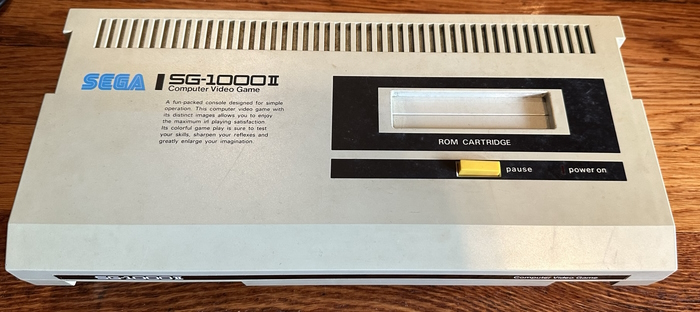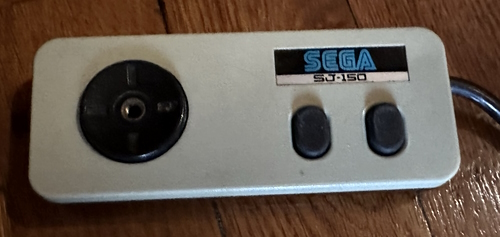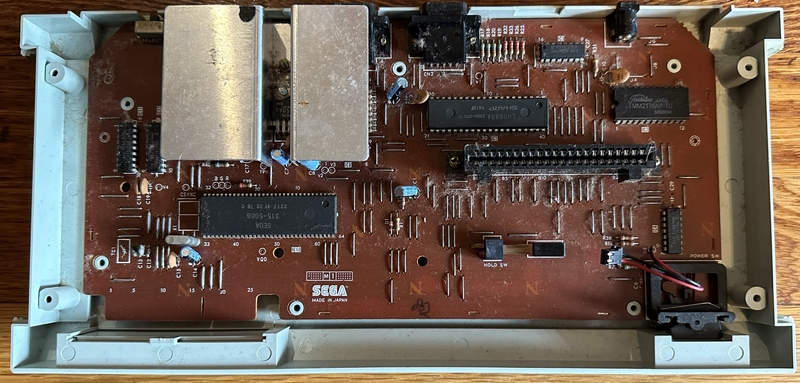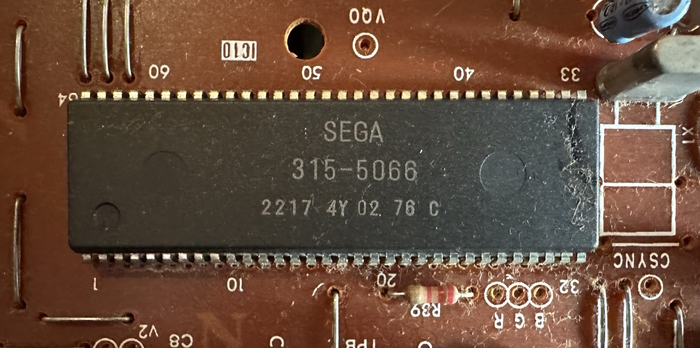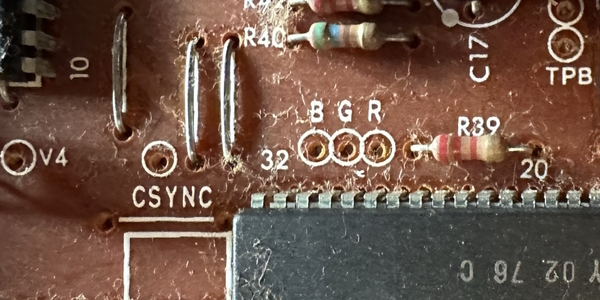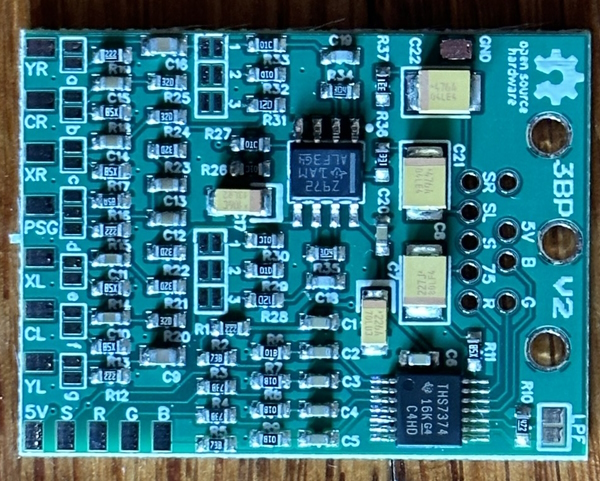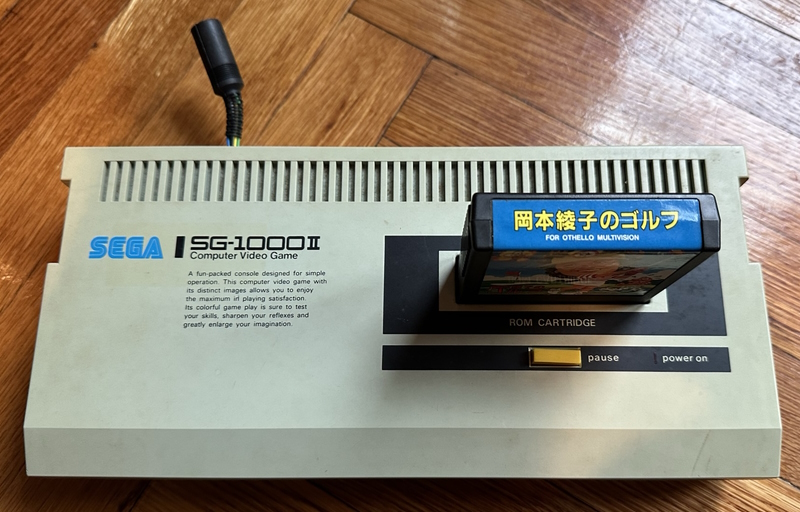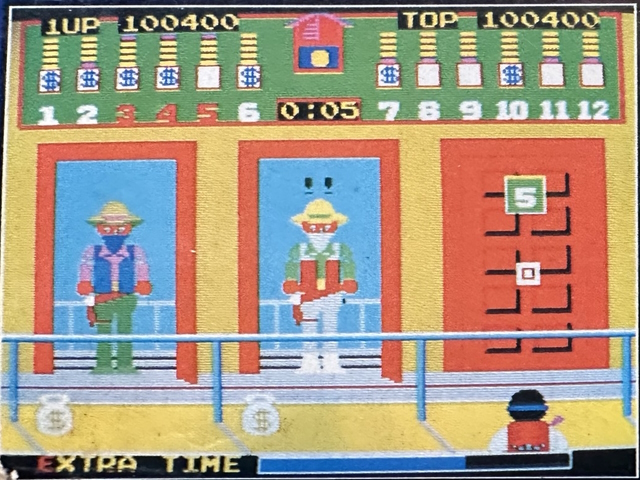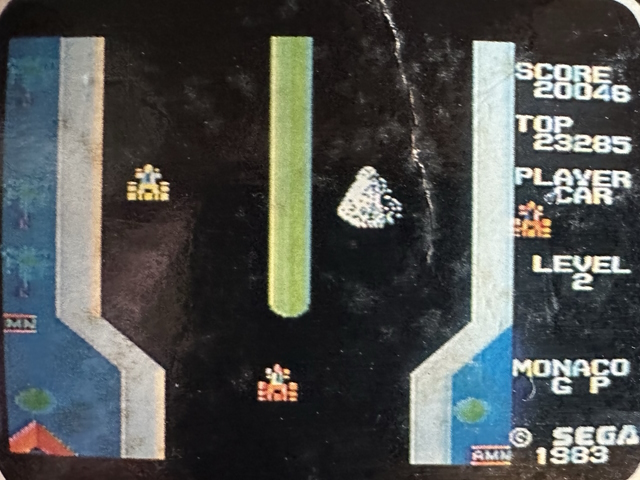RGB Modding the SG-1000 II! Is it worth it?
The SG-1000 II is often just considered the SG-1000 in a different box. And that is somewhat true! There are no games exclusive to the SG-1000 II. No graphics modes. No sound features. But yet, this variant of Sega’s first console features huge changes, and its DNA probably continued to echo down the Sega lineage to the Genesis. How so? And will an RGB mod always solve your problems?
SG-1000
The SG-1000 was Sega’s first home video game console. It definitely isn’t a ColecoVision in a different box, but it may or may not be identical to the ColecoVision except for minor port differences and missing the ColecoVision’s copyrighted ROM. It hasn’t shown up in this blog, but its computer cousin, the SC-3000 has.
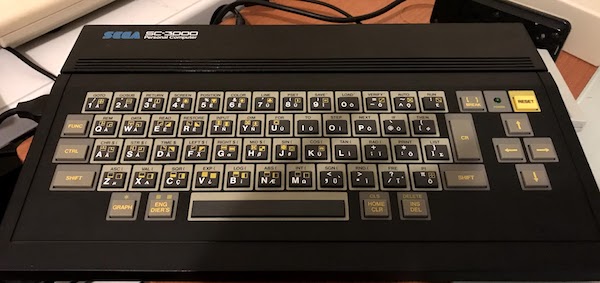
The SG-1000 came out on the same day as the Nintendo Famicom. And the Nintendo Famicom destroyed it in almost every way. Note that these are based off of the 1983 specs; things like mappers didn’t show up until later. (The SG-1000 would get some mapper-using games too, like Loretta no Shouzou and… that’s pretty much it)
| Sega SG-1000 | Nintendo Famicom | Winner | |
|---|---|---|---|
| CPU | 3.5 MHz Z80 | 1.7 MHz 6502-like | Tie* |
| WRAM | 1 kiB | 2 kiB | Nintendo |
| VRAM | 16 kiB | 2 kiB + 256b OAM | Sega |
| Cartridge ROM | 32 kiB | 32 kiB | Tie |
| Cartridge RAM | 8 kiB | 2-4 kiB | Sega |
| Cartridge VROM | 0 kiB | 8 kiB | Nintendo |
| Controller buttons | 6 | 8 | Nintendo |
| Sound channels | ~3 square + noise | 2 square + noise + PCM + triangle | Nintendo |
| Resolution | 256x192 | 256x224 | Nintendo |
| Color palette | 16 colors | ~54 colors | Nintendo |
| Sprite count | 32 | 64 | Nintendo |
| Sprites/scanline | 4 | 8 | Nintendo |
| Colors per sprite | 1 | 3 | Nintendo |
| Colors per tile | 2 per 8x1 tile** | 4 per 8x8 tile | Tie |
| Hardware tilemap scrolling | No | Yes | Nintendo |
* - Call me a 6502 fangirl if you wish
** - Mode 2, which most games used
Now, this isn’t quite fair. Most of the limitations of the Sega SG-1000 come from its Texas Instruments TMS9918A video chip, designed back in 1981 for the TI-99/4A computer. Nintendo and their graphics chip designer, Ricoh, could and did learn from its limitations and expand upon them. But Sega doesn’t get any points for using an earlier chip.
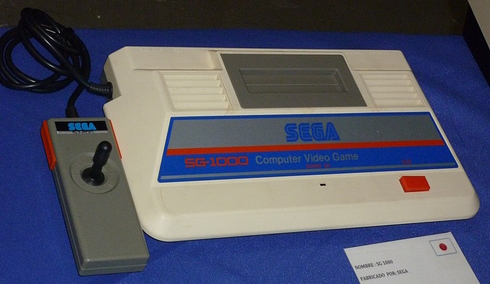
Another way the SG-1000 was dated at launch was its hardwired controller. Sure, the Nintendo Famicom had hardwired controllers too. But it wasn’t being hardwired that was the issue; it was the style. The Famicom introduced the patented cross-shaped D-pad and buttons that took the gaming world by storm; the SG-1000 had one more button than the Atari 2600 (released as the 2800 in Japan, for some reason) but kept a similar joystick controller form factor; very reminiscent of the later Atari 7800 joystick, but without the wedge.
That being said, Sega did pretty well for itself at first, with far more releases than Nintendo, who were also distracted by a costly hardware recall. (Early Famicoms that were subject to the recall have square-shaped A and B buttons) But by 1984 the tide began to shift dramatically, especially with Namco bringing on excellent ports of its arcade hits. (Namco and Nintendo are great friends, surely this won’t change in the US) The SG-1000 was flagging, and a full-scale “Famicom boom” was happening.
So what did Sega do? Got a new box to shove it all in.
The SG-1000 II is an SG-1000 in an admittedly sleek, modern-looking box. It has the same hardware capabilities. It has the same software capabilities. They didn’t even add a card slot for the thin “MyCard” hardware that would come the next year. At least they redesigned that controller.
It’s definitely a lot more Famicom-like. The controller is designed to have a small joystick screw into the directional circle, but I don’t really ever see them show up in auctions, so I’m assuming the fiddly joysticks were either quickly lost or never installed. You don’t need them anyway. Notice the buttons are unlabeled, like the original SG-1000. The left button maps to the left button, and the right to the right. This is a bit annoying as SG-1000 games usually treat the left button as the main action, but it was kind of inevitable thanks to needing to remain compatible with older hardware.
So what?
So the SG-1000 II is basically an SG-1000 in a better box, right? Well, not quite. Some SG-1000 IIs are SG-1000s in a better box, featuring the same exact TMS9918A video chip and the same SN76489A sound chip. But some… go beyond.
This particular SG-1000 II has neither of the chips I just mentioned. Despite having a quite large single-sided circuitboard, the major chips are heavily consolidated into a single large VDP (Video Display Processor).
The Sega 315-5066 is a major historical milestone. As far as I know, this is the first fully-integrated Sega VDP; arcade boards like the System 1 used a mix of helper chips and discrete logic. This VDP design, including the integrated SN76489A clone, would go on to be expanded upon by the Sega Master System, and a similar VDP (with the Master System graphics mode and the SN76489A, but no SG-1000 modes) would serve in the Genesis, eventually evolving into the Genesis-on-a-chip seen in the final Genesis 3 models.
What’s that? You don’t care about the historical significance of the chip? Well, maybe you’ll care about this:
The SG-1000 only has an RF output, and the SG-1000 II is the same. Using the same adapter I used back in 1978, I tried to get an RF output here, but I couldn’t get anything the Framemeister could read. And what the Trinitron could see, didn’t live long… fortunately.
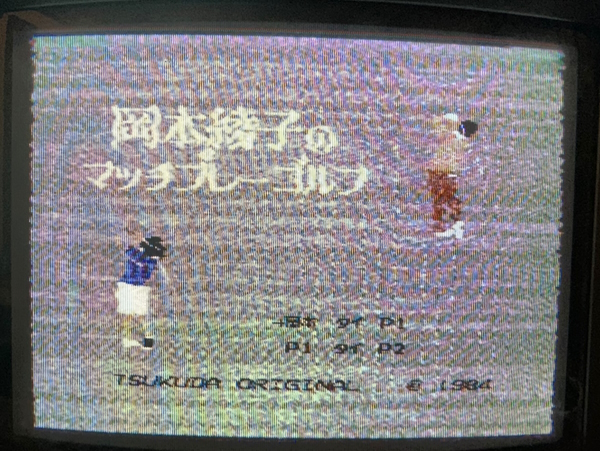
The TMS9918A is, like the Famicom, a naturally composite beast. It has no better video output (though later modles, the TMS9928A and PAL TMS9929A, including that used in my PAL SC-3000, do have component capability), and doesn’t use RGB internally as far as I know. But here the Sega VDP is offering us a promise of RGB video, with CSYNC. How can we resist?
Triple bypass? Nope
My original plan was to use a Sega Genesis Triple Bypass board. I figured I could use the PSG input for the audio (which is, after all, PSG), and give it RGB and sync. The Triple Bypass was painstakingly developed using the most advanced techniques for the Sega Genesis, but this earlier Sega VDP should be fine, right?
Well, it didn’t work. And I’m fairly certain it’s not the Triple Bypass’s fault; other people have done it with this model. I suspect I must have either fried the amplifier, or just got bad luck and had a defective one. You see, I could see the signal.
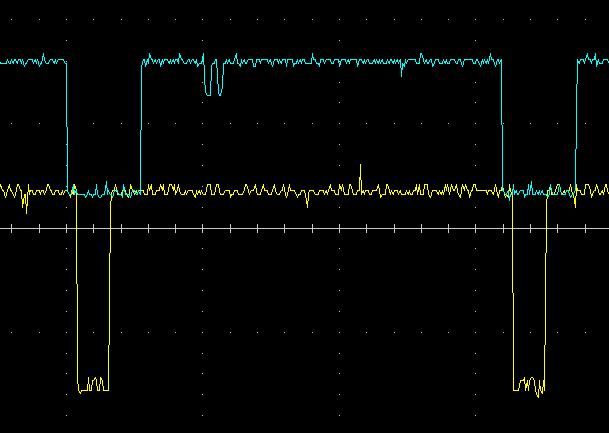
Here’s an image I was able to grab with my oscilloscope. Remember, my oscilloscope is not very good, and can’t capture the full detail of a video signal. Don’t worry about the specific voltages here, since my setup was very ad-hoc and not trustworthy. Nevertheless, the yellow trace is the CSYNC output, with the vertical sync pulses video. The other trace is the green video input.
The game in question is the title screen of Okamoto Ayako no Match Play Golf, the same game I played using RF above. This isn’t actually an SG-1000 game, it’s an Othello Multivision game, but they’re also the same console so it’s fine. In any case, the title screen is pretty much entirely green, as you can see from this emulator screenshot.
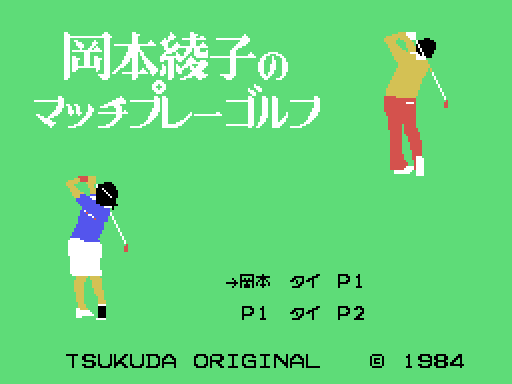
But while green signal came in, as did 5V and ground, nothing came out of the amplifier. I could also tell the SG-1000 was working correctly, because by wiring to a nearby testpoint labeled TP1 (see this tweet for details) I was able to get a fairly nice composite output without even needing an amplifier. Well, it’s plagued by jailbars, but those are also a tradition in Sega consoles that started here.
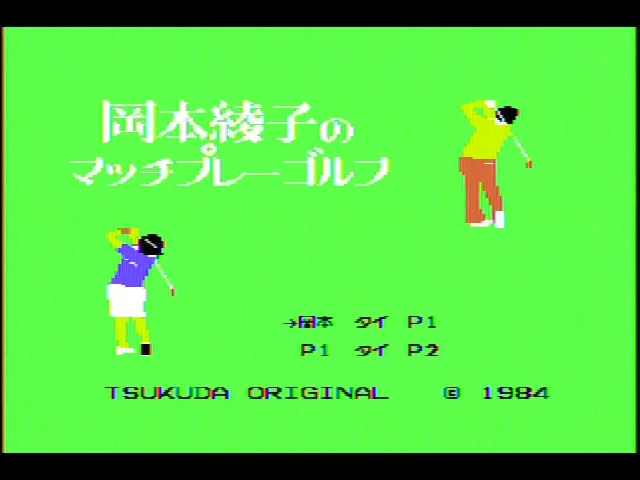
So, what’s a Nicole to do? This was last weekend, I wanted to get a post out today, and didn’t want to just buy another Triple Bypass board in case the issue was something else. If only I had a device that was designed to take raw Sega VDP RGB signals, and amplify them externally before sending them to a SCART output…
La solution française
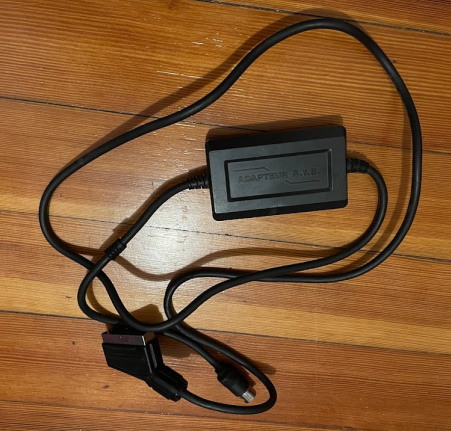
That’s right, the Sega Adapteur R.V.B., which came with certain models of the Sega Master System sold in SECAM territories. You can check out my earlier post for the details, but essentially, this baby is three simple transistor amplifiers, as the French Sega Master System 2 contains no internal video amplifier.

So I was able to wire those up, getting the audio from the site of the RF amplifier, which I had removed earlier. The Adapteur RVB doesn’t actually use the composite video pin, but I wired that up as well so I could have any output I wish. Best to be flexible.

Unfortunately, I didn’t have any panel-mount 8-pin DIN connectors compatible with Sega’s weird U-shaped version. And yeah, fine, my SG-1000 looks pretty silly with a tail sticking out the back.
But you know what doesn’t look silly? Crisp, beautiful RGB video.
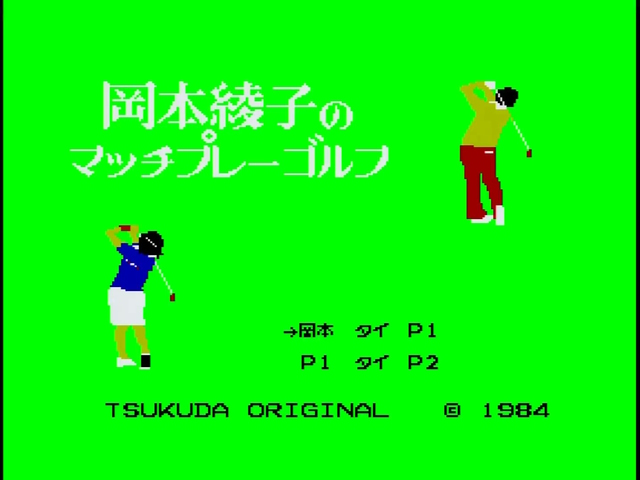
But… that green’s a little bright, isn’t? The signal is pretty hot (as is the Master System 2 with this cable), but even with some manual adjustment of the analog/digital converter in the Framemeister, it is this saturated in reality.
Dare to compare
But something’s up. Here’s a screenshot I took from my SC-3000, of the game Bank Panic. You might remember it from my video about using PAL video in North America.
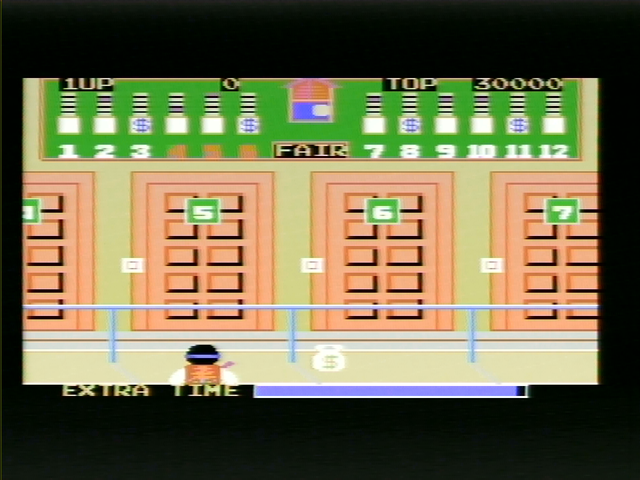
And now here’s the same game, on the same Framemeister, captured over composite using the Sega SG-1000 II.
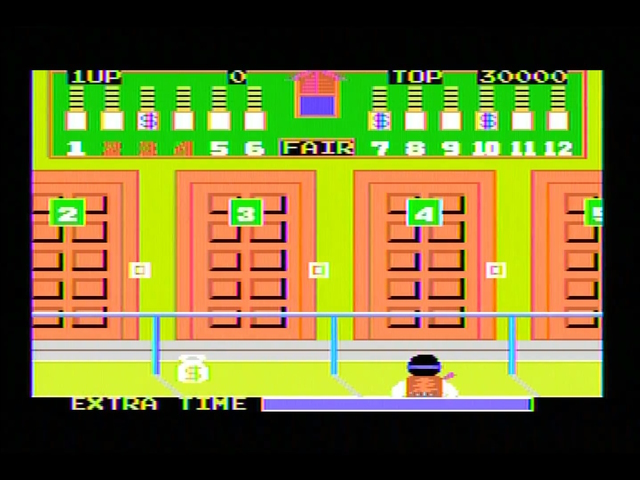
Notice that the colors are a bit more vibrant; I’m not sure if that’s chalked up to PAL/NTSC differences or not, but this to my eye looks closer to, say, an emulator screenshot, which agrees with SMS Power’s palette discussion.
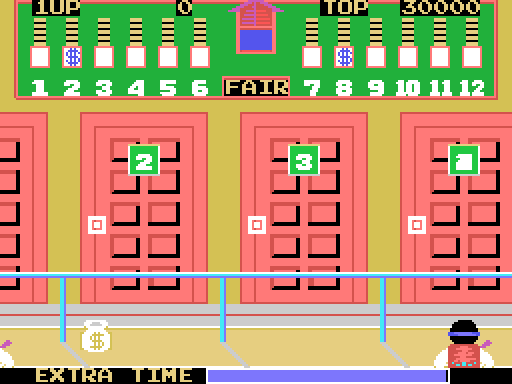
By comparison, our RGB signal is downright comical by comparison. The signal is hot and the colors are hotter, much more saturated.

That being said, it’s still a lot closer than the SMS compatibility palette I was hoping to avoid by doing all this:
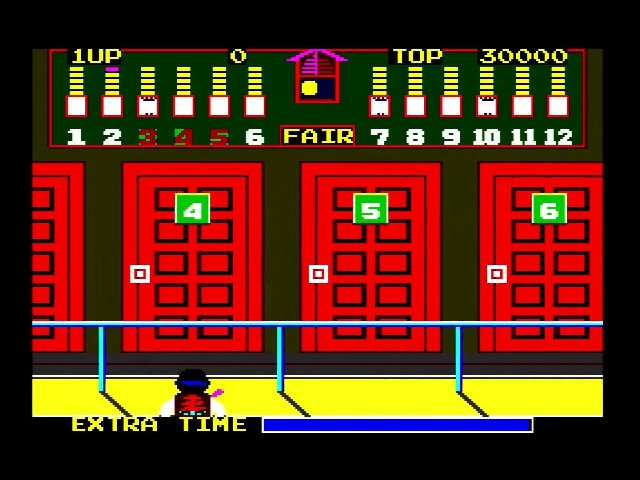
So how should Bank Panic look? One option might be to look at the box itself, which contains a screenshot. Judging by the slight lightness on the edges, I think this was a photo of a high-quality composite or RF TV, but I could be wrong. Of course, the box has also suffered nearly forty years of wear and tear.
Le problème monégasque
Another game that really suffers from this is Monaco GP. Here it is in composite mode. Notice the pale blue on the sides of the road.
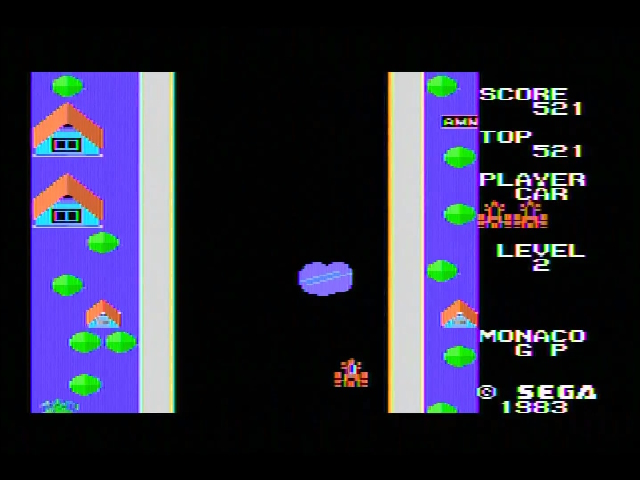
And now let’s take a look over RGB.
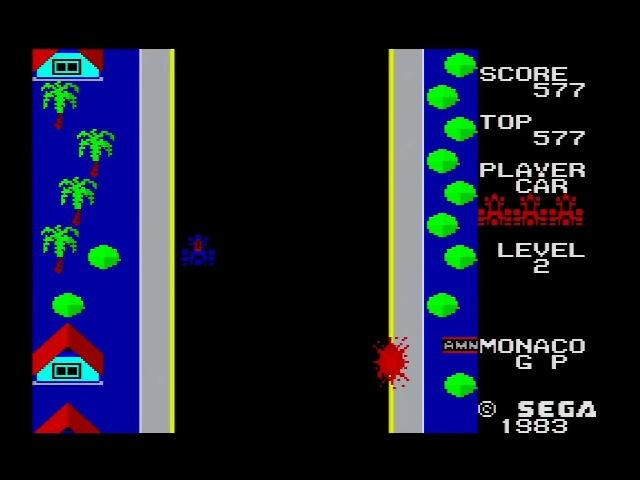
Note that this is not the same as the Master System compatibility mode, which has an even darker blue.
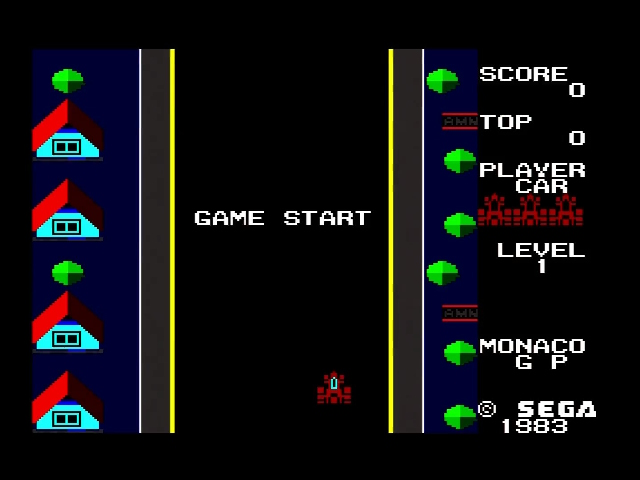
And the box is here too, but my box for this game is in quite bad condition. Still, the blue has the same greenish desaturated tinge that the composite video, and the red is pale.
That shouldn’t be a surprise. While you could argue on Bank Panic, the text in Monaco GP has the slightest edge coloration; a clear sign of NTSC artifacting if there ever was one. This screenshot was definitely RF or composite; probably RF. It’s also likely a literal screenshot.
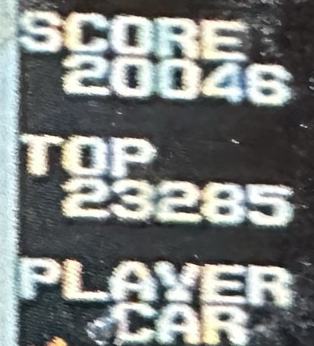
Conclusions?
It’s hard to draw conclusions here, but personally, I feel like composite might be the way to go for the SG-1000 II after all, even with the RGB mod. Some concerns might include the Adapteur R.V.B. producing an overly hot signal; it would’ve been nicer to get the Triple Bypass working. But overall, this reminds me of the (much more subtle) issue with the PC Engine/TurboGrafx palettes.
To confirm this, though, I’d like to do more tests. I’m currently waiting on some PCBs to allow me to run arbitrary programs on the SG-1000; the Master Everdrive sadly does not work on the older system.
Another option for TMS99xx-based machines is the TMS-RGB, which only works on TMS992x-based machines, but converts the component signals to an RGB output. That would be a good fit for my SC-3000, but I haven’t actually gotten that to work yet. And even then, as far as I know, no SG-1000 cartridge-based games were designed for PAL territories. Perhaps the TMS9928A could be adapted to work an original SG-1000?
My suspicion about the RGB signals here is that they were never intended for external consumption; note that the Sega VDP successors on the Master System and Genesis would feed their RGB output into a separate composite encoder. Here, they’re just test points, not used by anything. The separate composite signal is output by the VDP directly. (It would be very cool if the VDP outputs S-Video, but I’ve never heard that)
So, with all that said, perfect video output on the SG-1000 continues to elude me, much as market success eluded the SG-1000 II in Japan. Better luck next time, Sega.

A series on: The SG-1000 II
It's just a variant of Sega's "I can't believe it's not a ColecoVision", isn't it? Let's see how far it can go.
- RGB Modding the SG-1000 II! Is it worth it? — Where Sega was going, they didn't need TMS9918As. And that comes with some advantages-- but how big of an advantage is it?
- SG-1000 Smörgåsbord! Cartridges and RGB — Building some cartridges for Sega's SG-1000, and explaining why some early games that say they're 40kiB are actually just 16. Plus some attempts to refine the RGB mod.
- Bringing the Arcade Home, in 1984: The SG-1000 Arcade — Pushing the SG-1000 II to its limits by making it run games intended for its arcade counterpart. Some more console modding needed, but less than you might expect.

